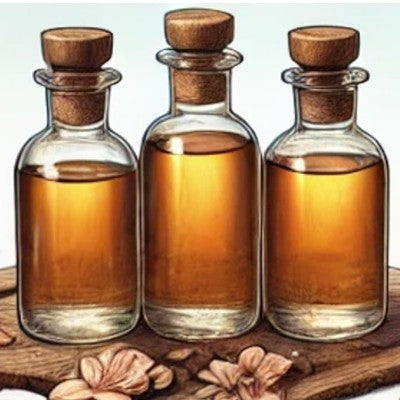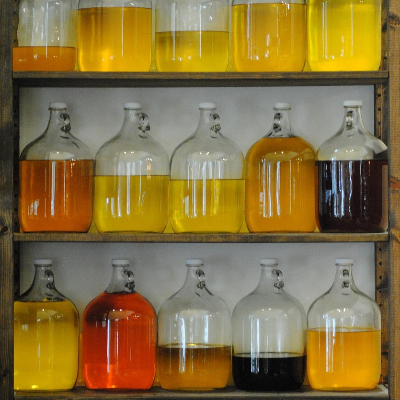Menu
-
-
F.A.Q
- How to identify genuine agarwood chip, natural or cultivated
- How to identify oil injection / absorption fake agarwood beads
- How to know if there are more than one oil in your oil
- How to make your wood bracelet or mala darker
- How to tell if an Agarwood bead sinks WITHOUT sinking it under water?
- How does back flow incense work and how do you burn it?
- Where to start if you don't know what agarwood is ?
- Why are you losing money if you buy seeds and plants?
- Which agarwood incense should I choose?
- Frequently Asked Questions
- Agarwood Related Articles
- Shipping
-
SHOP - Agarwood
-
SHOP - Other Fragrant Wood
-
SHOP - Incense Holder and Burner
-
- FREE Oud Oil guide
- Testimonials
- "Why did you buy this?"
- Contact us
- About Us
- +61430284329
- Login
-
English


The Hidden Costs: Why Producing Agarwood Oil is so expensive?
August 02, 2024 6 min read
Table of Contents:[hide]
Some numbers about Agarwood Oil Production
Recently in a local library, I had a chance to read a not-so-old but interesting newspaper article from the Daily Mirror Sri Lanka titled "Dharmasena’s agarwood project faces Yorker from Central Bank" (By Karunathilaka, P. S., 2024, May 29).
I learnt a few things and wanted to share them with you.
Agarwood, often referred to as “liquid gold,” is renowned for its unique and captivating fragrance, which has made it a precious commodity in perfumery and traditional medicine. Understanding the intricate process of Agarwood oil production can deepen your appreciation for this extraordinary substance. Let us delve into the details of Agarwood oil extraction.
Agarwood Oil Extraction Process
Boiler Capacity and Requirements

The extraction process begins with the selection and preparation of Agarwood. Each boiler used in the extraction process has a capacity requirement of 50 kilograms of Agarwood. This wood is carefully measured and prepared to ensure the optimal yield of oil.
Processing Time
Once the Agarwood is placed in the boiler, it undergoes a meticulous extraction process that takes between 8 to 10 days. This extended processing time is crucial to ensure that the maximum amount of oil is extracted from the wood.
Average Oil Yield
From every 50 kilograms of Agarwood, approximately 75 millilitres of oil is produced. This relatively small yield highlights the preciousness and value of Agarwood oil, as significant amounts of raw material are required to produce even a small quantity of the final product.
Oil Yield Calculation (Example 1):
- For every 50 kilograms of Agarwood, the oil yield is 75 millilitres.
- Assuming the density of Agarwood oil is approximately 0.8 grams per millilitre:
- 75 ml × 0.8 g/ml = 60 grams of oil.
- Percentage Yield = (60 grams of oil / 50,000 grams of Agarwood) × 100 = 0.12%
Parts of the Agarwood Tree
The parts of the Agarwood tree that contain oil are particularly valuable. These oil-containing parts typically weigh between 2 to 3 kilograms per tree, although in some cases, they can range from 4 to 5 kilograms. Additionally, from one Agarwood tree, it is possible to obtain 500 to 1000 grams of wood chips, which are essential in the oil extraction process.

Source: supplied by our growing partners.
Boiler Operations
Agarwood Requirement per Boiler
In the article, the boiler operations are tailored to maximise efficiency. Each boiler requires 30 kilograms of Agarwood for a processing period of 8 to 10 days. This slight reduction in quantity compared to the initial example suggests a tailored approach to different processing environments.
The actual Oil Yield
The yield of oil mentioned in the article is calculated at 20 grams of oil per 30 kilograms of Agarwood. This metric underscores the importance of precise measurements and processing conditions in determining the final output of Agarwood oil.
Percentage Yield (Example 2):
(20 grams of oil / 30,000 grams of Agarwood) x 100 = 0.067%, which is even smaller than the average yield above.
The Challenge for Agarwood farmers:
- Low Yield: Extracting Agarwood oil from the wood is challenging because the yield is very low. This means a lot of wood is needed to produce just a small amount of oil.
- High Cost: Due to the low yield, Agarwood oil is expensive, and producers are always looking for ways to increase the amount of oil they can extract from the wood.
Naturally, agarwood distillers would like to increase their yield. They want more oil for the same amount of wood.
How do they do that?

From the below article:
Fazila, K. N., & Halim, K. K. (2012). EFFECTS OF SOAKING ON YIELD AND QUALITY OF AGARWOOD OIL. Journal of Tropical Forest Science, 24(4), 557–564. http://www.jstor.org/stable/23617103
How to improve Agarwood oil yield?
The Solution: Soaking in Lactic Acid
To tackle this challenge, scientists have discovered that soaking Agarwood in lactic acid can improve the extraction process. Here is how it works:
What is Lactic Acid?
Lactic acid is a natural compound that can be found in sour milk products like yogurt. It is a mild acid that is often used in food and skincare products.
The human body also produces Lactic Acid; click here to learn more.
Anyway, let us go back to Lactic Acid and its role in Agarwood oil yield improvement.
How Does Soaking Help?
- Reduces Vaporisation Temperature: When Agarwood is soaked in a solution of lactic acid, it lowers the temperature at which the oil evaporates. This makes it easier to extract the oil without using too much heat, which can damage the quality of the oil.
- Enlarges Wood Pore Size: Soaking the wood in lactic acid also helps to open up the pores (tiny holes) in the wood. When the pores are larger, the oil can flow out more easily during the extraction process.
Benefits of This Method:
- Increased Oil Yield: By opening up the wood and making the oil easier to extract, soaking in lactic acid allows producers to get more oil from the same amount of wood. This means less waste and more product.
- Improved Oil Quality: The process not only increases the quantity but also maintains or even enhances the quality of the oil, as it is extracted under gentler conditions.
Potential for Industry:
This method of using lactic acid for soaking Agarwood has the potential to revolutionise the industry by making the production of Agarwood oil more efficient. It allows producers to extract higher-quality oil in larger quantities, potentially reducing costs and increasing availability.
Soaking Agarwood in lactic acid is a promising technique for improving the efficiency and quality of Agarwood oil production. By making it easier to extract more oil from the wood, this method can help meet the high demand for this precious oil while also ensuring that the product remains of excellent quality.
I know what you are thinking.
If it is soaked in the lactic acid, would this contaminate or affect the oil quality in any way?
When Agarwood is soaked in lactic acid, the concern about contamination of the extracted oil with lactic acid is valid. However, the process is typically designed to minimise or eliminate such contamination. Here is a detailed explanation of how this is managed:
Mitigating Contamination
-
Rinsing and Drying:
- After soaking the Agarwood in lactic acid, the wood is usually thoroughly rinsed with water to remove any residual acid.
- The Agarwood is then dried, which further reduces the presence of any remaining acid on the surface of the wood.
-
Hydrodistillation Process:
- The oil extraction is carried out using hydrodistillation, where the Agarwood is distilled with water. During this process, the essential oils are separated from the water and other non-volatile substances, including any residual acids.
- The volatile nature of essential oils allows them to be distilled off, while non-volatile contaminants like lactic acid remain in the aqueous phase and are not carried over into the distilled oil.
-
Separation and Purification:
- After hydrodistillation, the oil and water mixture is separated using a separation funnel. Lighter fractions (the oil) float on top, while heavier aqueous fractions containing any dissolved acids remain at the bottom.
- Further purification steps, such as filtering and possibly additional distillation, ensure that the final oil product is free from contaminants.
Analytical Verification
-
Gas Chromatography-Mass Spectrometry (GC-MS):
- GC-MS analysis is used to verify the chemical composition of the extracted oil. This analysis can detect the presence of lactic acid or any other contaminants at very low concentrations.
- The study mentioned utilised GC-MS to ensure that the final product is of high quality and free from undesired impurities.
Practical Observations
The study "Effects of Soaking on Yield and Quality of Agarwood Oil" concluded that soaking in lactic acid did not negatively impact the quality of the Agarwood oil. The following points were highlighted:
- The oil extracted from lactic acid-soaked Agarwood showed high quality with a rich composition of desired aromatic compounds.
- The soaking process effectively enhanced the yield and did not introduce detectable levels of lactic acid into the final oil product, as confirmed by GC-MS analysis.
Final words
While the initial soaking in lactic acid serves to enhance the extraction efficiency by enlarging wood pore sizes and facilitating the release of oil, the subsequent steps in the extraction process ensure that the final Agarwood oil is free from lactic acid contamination. Proper rinsing, drying, hydrodistillation, and purification techniques are critical to achieving this outcome. Analytical techniques like GC-MS provide the necessary verification to confirm the purity and quality of the extracted oil.
Leave a comment
Comments will be approved before showing up.
Also in News

What is Tasbih? The Deep Meaning of Subhan Allah and the Role of Prayer Beads
November 09, 2025 4 min read

